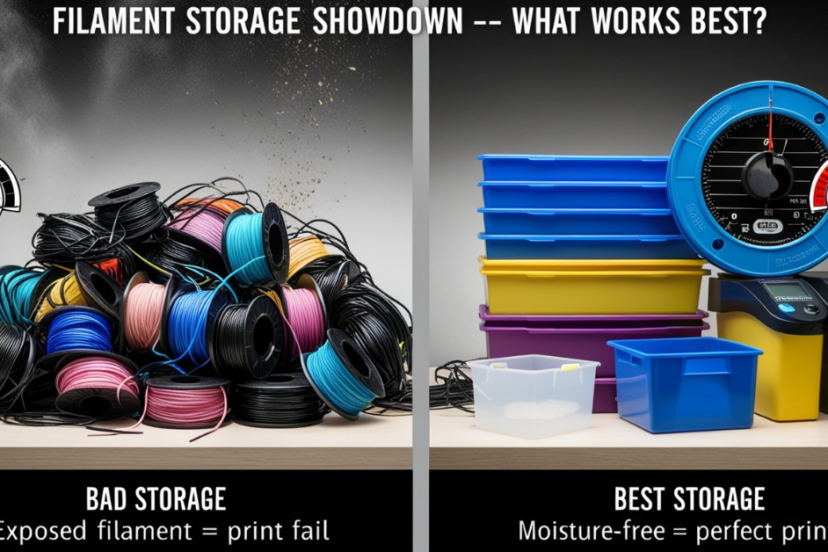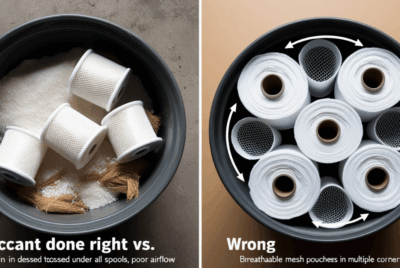What’s the best filament storage solution?
The best filament storage solution depends on your specific needs, such as how often you print, the types of filament you use, and how long you plan to store the filament. However, the most effective filament storage solutions are those that keep filament dry, prevent damage, and maintain optimal printing conditions. Here are the top filament storage solutions:
1. Vacuum-Sealed Bags with Desiccants
Why It’s the Best: Vacuum-sealed bags are one of the most effective ways to keep filament dry and protected from moisture, especially for long-term storage.
- How It Works:
- Place filament spools in vacuum-sealed bags along with desiccant packets (such as silica gel or clay desiccants) to absorb moisture.
- Use a vacuum sealer to remove air from the bag and create a moisture-proof seal.
- Benefits:
- Completely prevents moisture from entering the bag.
- Easy to store and access filament when needed.
- Ideal for long-term storage.
- Best For: Storing filament for extended periods or in high-humidity environments.
2. Filament Dry Box with Built-In Desiccant
Why It’s the Best: A filament dry box is specifically designed for filament storage, keeping it dry and protected from moisture while you’re printing.
- How It Works:
- These boxes come with built-in desiccants or humidity control features. Some even have heating elements to keep the filament dry and ready for use.
- Filament can be placed directly inside the box, where it remains sealed and moisture-free.
- Benefits:
- Protects filament from moisture during both storage and printing.
- Keeps filament at a controlled humidity level to maintain optimal printing conditions.
- Convenient if you’re printing with the filament regularly.
- Best For: Active printing environments where filament is in frequent use but still needs to be stored properly.
3. Airtight Storage Containers with Desiccants
Why It’s the Best: Airtight containers are simple, effective, and inexpensive for protecting filament from moisture.
- How It Works:
- Store filament in airtight plastic bins or containers with tight-fitting lids.
- Place desiccant packs inside the container to absorb any moisture.
- Benefits:
- Keeps filament safe from moisture and dust.
- Inexpensive and easy to implement.
- You can stack or organize multiple spools inside these containers.
- Best For: Short to medium-term storage, especially for hobbyists who print frequently.
4. Desiccant Drying Cabinets
Why It’s the Best: Desiccant drying cabinets are ideal for storing filament long-term and ensuring it’s kept in a dry environment.
- How It Works:
- These cabinets are designed with desiccant materials that naturally absorb moisture.
- The filament spools are placed inside the cabinet, where the desiccants continually maintain a dry environment.
- Benefits:
- Prevents filament from absorbing moisture, ensuring it’s ready for high-quality prints.
- Suitable for industrial or professional setups with large quantities of filament.
- Best For: Long-term storage in professional or industrial environments with a large inventory of filament.
5. Filament Storage Spool Holders with Humidity Control
Why It’s the Best: These filament spool holders are a great solution for preventing moisture from affecting filament while it’s in use during printing.
- How It Works:
- Store the filament spool on a dedicated holder that includes a desiccant compartment or a controlled drying chamber.
- Some models even offer adjustable temperature control to keep the filament dry as it’s used during printing.
- Benefits:
- Prevents moisture buildup while the filament is being used.
- Keeps filament dry and ready for immediate use.
- Best For: Active printing environments where moisture prevention is important during both storage and printing.
6. Use of Silica Gel Packs or Clay Desiccants
Why It’s the Best: These are inexpensive and easy-to-use solutions for maintaining a dry environment for filament storage.
- How It Works:
- Silica gel or clay desiccants are placed inside storage containers or vacuum-sealed bags with the filament.
- The desiccants absorb excess moisture from the air, keeping the filament dry.
- Benefits:
- Inexpensive and effective.
- Simple to implement with any storage solution.
- Best For: Use in combination with airtight containers, vacuum-sealed bags, or dry boxes.
7. Temperature-Controlled Dry Cabinets (with Dehumidification)
Why It’s the Best: These cabinets offer precise control over temperature and humidity, making them one of the best solutions for filament storage, especially in high-humidity areas.
- How It Works:
- The cabinet has built-in heating and dehumidification elements, which keep filament at a consistent temperature and low humidity.
- Often used for industrial or high-end home setups.
- Benefits:
- Keeps filament at optimal humidity and temperature, preventing moisture damage.
- Ideal for high-value or specialty filaments like Nylon or flexible filaments.
- Best For: Professional, industrial, or high-end home setups with a large variety of filaments.
Summary
The best filament storage solution depends on your needs:
For long-term storage and maximum protection: Vacuum-sealed bags or desiccant drying cabinets are top choice.
For active printing environments: Filament dry boxes or airtight containers with desiccants are highly effective.
For cost-effective moisture control: Silica gel packs or simple storage containers with tight lids work well for hobbyists and smaller setups.
No matter which method you choose, keeping filament stored in a dry, stable environment will significantly improve print quality, reduce the risk of warping or moisture-related issues, and extend the lifespan of your filament.




